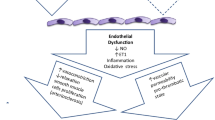Abstract
Although smooth muscle and endothelial cells in pig coronary artery are morphologically and functionally distinct, ascorbate uptake has been characterized only in smooth muscle cells. Ascorbate transporters in kidney and intestinal epithelial cells differ from those in smooth muscle. We examined ascorbate transport and mRNA expression of sodium-dependent vitamin C transporters (SVCT) by RT-PCR in the pig coronary artery endothelial cell cultures. When 14C-ascorbate uptake in endothelial cells was examined as 14C or by HPLC, the two values did not differ from each other. 14C-ascorbate uptake was Na+-dependent, stereoselective for l-ascorbate and inhibited by sulfinpyrazone. The kinetic characteristics of the uptake were: Km = 27± 3 μM (Hill coefficient = 1) for ascorbate and Km = 73± 14 mM (Hill coefficient = 2) for Na+. Surprisingly, endothelial cells had similar kinetic parameters as smooth muscle cells, except for a slightly lower uptake velocity in endothelial cells. Comparison with the smooth muscle showed that both tissue types expressed mRNA for SVCT2. Endothelial cells differ from epithelial cells which express mainly SVCT1 but resemble smooth muscle cells in this respect. (Mol Cell Biochem 271: 43–49, 2005)
Similar content being viewed by others
Abbreviations
- DHAA:
-
dehydroascorbic acid
- DTT:
-
dithiothreitol
- G3PDH:
-
glyceraldehyde 3-phosphate dehydrogenase
- HEPES:
-
4-(2-hydroxyethyl-1-poperazine ethane sulfonate
- NMG:
-
N-methyl-glucamine+
- PCEC:
-
pig coronary artery endothelial cells
- PCSMC:
-
pig coronary artery smooth muscle cells
- SERCA:
-
sarco/endoplasmic reticulum Ca2+ isoform
- SVCT:
-
sodium-dependent vitamin C transporters
References
Kirsch M, de Groot H: Ascorbate is a potent antioxidant against peroxynitrite-induced oxidation reactions. Evidence that ascorbate acts by re-reducing substrate radicals produced by peroxynitrite. J Biol Chem 275: 16702–16708, 2000
Rowe DJ, Ko S, Tom XM, Silverstein SJ, Richards DW: Enhanced production of mineralized nodules and collagenous proteins in vitro by calcium ascorbate supplemented with vitamin C metabolites. J Periodontol 70: 992–999, 1999
Alul RH, Wood M, Longo J, Marcotte AL, Campione AL, Moore MK, Lynch SM: Vitamin C protects low-density lipoprotein from homocysteine-mediated oxidation. Free Radic Biol Med 34: 881–891, 2003
Tessier F, Moreaux V, Birlouez-Aragon I, Junes P, Mondon H: Decrease in vitamin C concentration in human lenses during cataract progression. Int J Vitam Nutr Res 68: 309–315, 1998
Ek A, Strom K, Cotgreave IA: The uptake of ascorbic acid into human umbilical vein endothelial cells and its effect on oxidant insult. Biochem Pharmacol 50: 1339–1346, 1995
May JM, Qu ZC, Li X: Ascorbic acid blunts oxidant stress due to menadione in endothelial cells. Arch Biochem Biophys 411: 136–144, 2003
Christofidou-Solomidou M, Scherpereel A, Wiewrodt R, Ng K, Sweitzer T, Arguiri E, Shuvaev V, Solomides CC, Albelda SM, Muzykantov VR: PECAM-directed delivery of catalase to endothelium protects against pulmonary vascular oxidative stress. Am J Physiol Lung Cell Mol Physiol 285: L283–L292, 2003
Jacob RA, Burri BJ: Oxidative damage and defense. Am J Clin Nutr 63: 985S–990S, 1996
Grover AK, Hui J, Samson SE: Catalase activity in coronary artery endothelium protects smooth muscle against peroxide damage. Eur J Pharmacol 387: 87–91, 2000
Heller R, Munscher-Paulig F, Grabner R, Till U: L-Ascorbic acid potentiates nitric oxide synthesis in endothelial cells. J Biol Chem 274: 8254–8260, 1999
Mak S, Egri Z, Tanna G, Colman R, Newton GE: Vitamin C prevents hyperoxia-mediated vasoconstriction and impairment of endothelium-dependent vasodilation. Am J Physiol Heart Circ Physiol 282: H2414–H2421, 2002
Utoguchi N, Ikeda K, Saeki K, Oka N, Mizuguchi H, Kubo K, Nakagawa S, Mayumi T: Ascorbic acid stimulates barrier function of cultured endothelial cell monolayer. J Cell Physiol 163: 393–399, 1995
Tsukaguchi H, Tokui T, Mackenzie B, Berger UV, Chen XZ, Wang Y, Brubaker RF, Hediger MA: A family of mammalian Na+-dependent L-ascorbic acid transporters. Nature 399: 70–75, 1999
Holmes ME, Samson SE, Wilson JX, Dixon SJ, and Grover AK: Ascorbate transport in pig coronary artery smooth muscle: Na(+) removal and oxidative stress increase loss of accumulated cellular ascorbate. J Vasc Res 37: 390–398, 2000
Grover AK, Samson SE: Peroxide resistance of ER Ca2+ pump in endothelium: implications to coronary artery function. Am J Physiol 273: C1250–C1258, 1997
Siushansian R, Wilson JX: Ascorbate transport intracellular concentration in cerebral astrocytes. J Neurochem 65: 41–49, 1995
Wilson JX, Dixon SJ, Yu J, Nees S, Tyml K: Ascorbate uptake by microvascular endothelial cells of rat skeletal muscle. Microcirculation 3: 211–221, 1996
Kannan R, Stolz A, Ji Q, Prasad PD, Ganapathy V: Vitamin C transport in human lens epithelial cells: Evidence for the presence of SVCT2. Exp Eye Res 73: 159–165, 2001
Schmidt T, Zaïb F, Samson SE, Kwan CY, Grover AK: Peroxynitrite resistance of sarco/endoplasmic reticulum Ca2+ pump in pig coronary artery endothelium and smooth muscle. Cell Calc 36: 77–82, 2004
Kaiser N, Sasson S, Feener EP, Boukobza-Vardi N, Higashi S, Moller DE, Davidheiser S, Przybylski RJ, King GL: Differential regulation of glucose transport and transporters by glucose in vascular endothelial and smooth muscle cells. Diabetes 42: 80–89, 1993
Khan I, Sandhu V, Misquitta CM, Grover AK: SERCA pump isoform expression in endothelium of veins and arteries: Every endothelium is not the same. Mol Cell Biochem 203: 11–15, 2000
Barnes KA, Samson SE, Grover AK: Sarco/endoplasmic reticulum Ca2+-pump isoform SERCA3a is more resistant to superoxide damage than SERCA2b. Mol Cell Biochem 203: 17–21, 2000
Grover AK, Samson SE, Misquitta CM: Sarco(endo)plasmic reticulum Ca2+ pump isoform SERCA3 is more resistant than SERCA2b to peroxide. Am J Physiol 273: C420–C425, 1997
Holmes ME, Mwanjewe J, Samson SE, Haist JV, Wilson JX, Dixon SJ, Karmazyn M, Grover AK: Dehydroascorbic acid uptake by coronary artery smooth muscle: Effect of intracellular acidification. Biochem J 362: 507–512, 2002
Author information
Authors and Affiliations
Corresponding author
Rights and permissions
About this article
Cite this article
Best, K.A., Holmes, M.E., Samson, S.E. et al. Ascorbate uptake in pig coronary artery endothelial cells. Mol Cell Biochem 271, 43–49 (2005). https://doi.org/10.1007/s11010-005-3442-0
Received:
Accepted:
Issue Date:
DOI: https://doi.org/10.1007/s11010-005-3442-0




